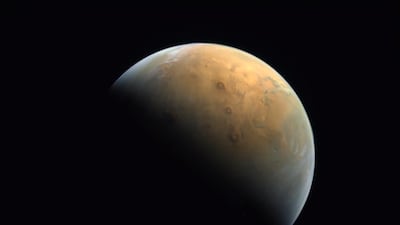An Emirati and an American author have written a children’s book inspired by the UAE’s mission to Mars in the hope it will encourage more young people to learn the Stem subjects of science, technology, engineering and maths.
Amal Goes to Mars! follows the story of a young girl named Amal, which means hope in Arabic, who goes on a mission to the Red Planet for the UAE.
The 32-page book was written by Shamma Al Qassim and Lisa La Bonte. It is written in Arabic and English.
It celebrates the country’s successful Mars mission, with the Hope probe currently orbiting the Red Planet and sending back valuable data about its atmosphere.
As an Emirati I feel proud of UAE's space achievements and as a mother I want my children to feel that pride too, and to understand that the future is bright
Shamma Al Qassim,
author
“The idea for the book was to tell the story of UAE’s historic Mars mission through the perspective of a personified Hope probe – a young girl named Amal,” La Bonte said.
“I wanted children and parents across the UAE to consider the endless possibilities and to expand that spirit to the Arabic and English-speaking worlds, adding basic highlights at the end of the story so more would learn about the Hope mission and keep an eye out for what's next in terms of the UAE’s space programmes and initiatives.
“These types of books with roots in space and Stem empower youth in the Arab world and encourage kids to think big.”
A book about a bright future
Amal looks similar to Hope probe, with a "body" shaped like the spacecraft and arms that represent the solar panels.
The book was launched last month at the International Astronautical Congress in Dubai – the world’s largest space conference – and is being sold at the Sharjah International Book Fair and bookshops for Dh50 ($13.60) until November 13.
The book will also be available on Amazon UAE soon and on upliftingbooks.org.
Qassim, who was one of the first Emiratis to receive an internship at Nasa, wrote the Arabic parts for the book.
"As an Emirati I feel proud of the UAE's space achievements and as a mother I want my children to feel that pride too, and to understand that the future is bright,” she said.
Since entering the Martian orbit on February 9, the Hope probe has been capturing atmospheric data using three science instruments.
So far, 110 gigabytes of the 1,000gb of data the mission is expected to collect has been released to the public.
The Mohammed bin Rashid Space Centre has promised new sets of data every three months.
Amateur astronomers create Mars pictures using Hope's data
Key facilities
- Olympic-size swimming pool with a split bulkhead for multi-use configurations, including water polo and 50m/25m training lanes
- Premier League-standard football pitch
- 400m Olympic running track
- NBA-spec basketball court with auditorium
- 600-seat auditorium
- Spaces for historical and cultural exploration
- An elevated football field that doubles as a helipad
- Specialist robotics and science laboratories
- AR and VR-enabled learning centres
- Disruption Lab and Research Centre for developing entrepreneurial skills
The National's picks
4.35pm: Tilal Al Khalediah
5.10pm: Continous
5.45pm: Raging Torrent
6.20pm: West Acre
7pm: Flood Zone
7.40pm: Straight No Chaser
8.15pm: Romantic Warrior
8.50pm: Calandogan
9.30pm: Forever Young
Iran's dirty tricks to dodge sanctions
There’s increased scrutiny on the tricks being used to keep commodities flowing to and from blacklisted countries. Here’s a description of how some work.
1 Going Dark
A common method to transport Iranian oil with stealth is to turn off the Automatic Identification System, an electronic device that pinpoints a ship’s location. Known as going dark, a vessel flicks the switch before berthing and typically reappears days later, masking the location of its load or discharge port.
2. Ship-to-Ship Transfers
A first vessel will take its clandestine cargo away from the country in question before transferring it to a waiting ship, all of this happening out of sight. The vessels will then sail in different directions. For about a third of Iranian exports, more than one tanker typically handles a load before it’s delivered to its final destination, analysts say.
3. Fake Destinations
Signaling the wrong destination to load or unload is another technique. Ships that intend to take cargo from Iran may indicate their loading ports in sanction-free places like Iraq. Ships can keep changing their destinations and end up not berthing at any of them.
4. Rebranded Barrels
Iranian barrels can also be rebranded as oil from a nation free from sanctions such as Iraq. The countries share fields along their border and the crude has similar characteristics. Oil from these deposits can be trucked out to another port and documents forged to hide Iran as the origin.
* Bloomberg








